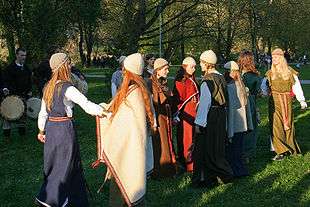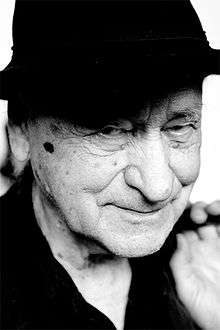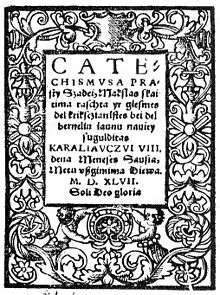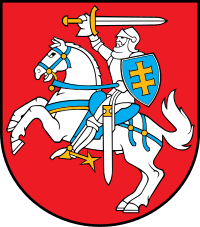Culture of Lithuania
| Part of a series on the |
| Culture of Lithuania |
|---|
 |
| History |
| People |
| Languages |
|
Mythology and folklore |
| Cuisine |
| Festivals |
| Religion |
| Literature |
|
Music and performing arts |
| Sport |
|
Monuments |
|
The culture of Lithuania combines an indigenous heritage, represented by the unique Lithuanian language, with Nordic cultural aspects and Christian traditions resulting from historical ties with Poland. Although linguistic resemblances represent strong cultural ties with Latvia in various historical moments Lithuania was influenced by Nordic, Germanic and Slavic cultures. Various cultural changes occurred throughout Lithuania's transformation from a former country of the Soviet Union to an independent Baltic state.
Ethnicity and nationality

Lithuania has the most homogeneous population in the Baltic states. In the 2001 census, 83.45% of the population identified themselves as ethnic Lithuanians, 6.74% as Poles, 6.31% as Russians, 1.23% as Belarusians, and 2.27% as members of other ethnic groups.[1] Poles in Lithuania are concentrated in the Vilnius Region, allowing Electoral Action of Poles in Lithuania, their ethnically-based party, to exert some influence. Russians, however, are relatively evenly spread throughout Lithuania. Lithuanians are usually divided into 5 groups: Samogitians, Sudovians, Aukštaitians, Dzūkians and Lietuvininks,[2] although the Lietuviniks are nearly extinct. City dwellers, however, are most often simply called Lithuanians.
Lithuania's ethnic composition has undergone significant changes throughout history. The most significant one of these was the extermination of Jews during the Holocaust. Before World War II, approximately 7.5% of Lithuanians were Jewish, referred to as Litvaks. The population of Vilnius was 30% Jewish. Almost all of Lithuania's Jews either were killed by Nazi Germany or emigrated, and the 2001 census only counted 4007 Jews.[1]
Language
Lithuanian is the official language of Lithuania. Lithuanian, an Indo-European language, closely resembles ancient Sanskrit, and is written using the Latin alphabet. It is considered by scholars that the Lithuanian language retained, with the fewest changes, most of the elements of Proto-Indo-European language.[3] Various dialects of Lithuanian exist, such as High Lithuanian (Aukštaitian) and Low Lithuanian (Samogitian).[4]
During the Lithuanian press ban (1864–1904), Lithuanian was censored by the Russians, and could only be written with the Cyrillic alphabet. Literature in the Lithuanian alphabet was burned and forbidden from publication. Schools, churches, courts, and newspapers faced heavy penalties if Latin text were to be displayed during these years, with violators even exiled to Siberia.[5]
Religion
Since the Christianization of parts of Lithuania proper in 1387 and of Samogitia in 1413, the majority of Lithuanians have been members of the Roman Catholic Church. According to the 2001 census, 79% of Lithuanians are Roman Catholic. Approximately 4.9% of the population are Eastern Orthodox, mainly the Russian minority.[6] Under Article 26 of the Constitution of Lithuania, persons can freely practice a religion of their choosing.[7]
Catholicism played a significant role in Lithuanian anti-communist resistance under the Soviet Union. Several Catholic priests were leaders of the anti-communist movements, and thousands of Latin rite crosses were placed on the Hill of Crosses near Šiauliai, despite its being bulldozed in 1961.
Education

Education in Lithuania exists from pre-school to adult education. Colleges and universities in Lithuania have undergraduate and higher education. Pre-school is for children aged three to six years. After pre-school, children enroll in primary school from seven to ten years of age. At eleven, students begin secondary school until the age of 18. Once the general education is completed, students go to college or university.[8] Students can take the UK exam to study overseas.[9] A bachelor's degree takes four years, traditionally, to complete. A master's takes one to two years to complete; and a doctoral degree takes four years.[10] Lithuania's oldest university is Vilnius University, which was founded in 1579.[11]
Food and lifestyle

Lithuanian cuisine features the products suited to its cool and moist northern climate: barley, potatoes, rye, beets, greens, berries, and mushrooms are locally grown, and dairy products are one of its specialities. Since it shares its climate and agricultural practices with Eastern Europe, Lithuanian cuisine has much in common with other Eastern European and Ashkenazi cuisines. Nevertheless, it has its own distinguishing features, which were formed by a variety of influences during the country's long and difficult history. German traditions also influenced Lithuanian cuisine, introducing pork and potato dishes, such as potato pudding (kugelis or kugel) and potato sausages (vėdarai), as well as the baroque tree cake known as šakotis. The most exotic of all the influences is Eastern (Crimean Karaites) cuisine, and the dishes kibinai and čeburekai are popular in Lithuania. Torte Napoleon was introduced during Napoleon's passage through Lithuania in the 19th century.
Media and art
Art and museums

Lithuania's art community is famous for Mikalojus Konstantinas Čiurlionis (1875–1911). Čiurlionis was a nationally renowned musician and artist in Lithuania. His symphonic compositions, Jūra ("The sea") and Miške ("In the forest"), were the first full length pieces from a Lithuanian musician. Jūra ("The sea") and Miške ("In the forest") were composed to represent Lithuania's landscape.[12] After Čiurlionis's death, the 2420 Čiurlionis asteroid honors his achievements after being discovered in 1975.
A large number of museums exist in Lithuania. The Lithuanian Art Museum was founded in 1933 and is the largest museum of art preservation and display in Lithuania.[13] The Palanga Amber Museum is a subsidiary of the Lithuanian Art Museum. Various amber pieces comprise a major part of the museum. In total, 28,000 pieces of amber are displayed, and about 15,000 contain inclusions of insects, spiders, or plants.[14] Some 4,500 amber pieces in the museum are used for artwork and jewelry.[15] A future museum, Vilnius Guggenheim Hermitage Museum, will present exhibitions of new media art, parts of the New York City anthology film archive, and Fluxus art. The museum is scheduled to open in 2011.[16]
The Lithuanian Museum of Ancient Beekeeping displays various forms of bee hives. The Grūtas Park contains Soviet-era relics and statues including those of Vladimir Lenin and Joseph Stalin.
Music

Lithuania has a long history of folk, popular and classical musical development. Lithuanian folk music is based primarily around polyphonic music played on flutes, zithers (kanklės) and other instruments.
Folk

Lithuanian folk music is based around songs (dainos), which include romantic, wedding songs, as well as work songs and more archaic war songs. Traditional vocal music is held in high esteem on a world scale: Lithuanian song fests and sutartinės multipart songs are on the UNESCO's representative list of the Masterpieces of the Oral and Intangible Heritage of Humanity. Folk songs were performed either in groups or alone, and in parallel chords or unison. Duophonic songs are common in the renowned sutartinės tradition of Aukštaitija. Another style of Lithuanian folk music is called rateliai, a kind of round dance. Instrumentation includes kanklės, a kind of zither that accompanies sutartines, rateliai, waltzes, quadrilles and polkas, and fiddles, (including a bass fiddle called the basetle), a kind of whistle called the lumzdelis and, similar in sound to clarinet, birbyne ; recent importations, beginning in the late 19th century, including the concertina, accordion and bandoneon. Sutartinė is accompanied by the skudučiai, a form of panpipes played by a group of people, as well as wooden trumpets (ragai and dandytės). The kanklės is an extremely important folk instrument, which differs in the number of strings and performance techniques across the country. Other traditional instruments include the švilpas (whistle), drums and tabalas (a percussion instrument like a gong), sekminių ragelis (bagpipe) and the pūslinė (a musical bow made from a pig's bladder filled with dried peas).
Rock
In the 1980s, rock bands Foje, Antis, and Bix made a big impact in Lithuania.
Cinema and theatre


Lithuania has a lively drama scene. Many film festivals exist, such as Kino Pavasaris and the AXX Commercial Film Festival Contest. Film tradition has emerged throughout Lithuania's occupation by the Soviet Union.[17] A popular Lithuanian film classic is Velnio Nuotaka, which is based upon folk tales.[18]
A major theater in Lithuania is the Lithuanian National Drama Theater. Another theatre, the Vilnius Little Theatre, was founded by Rimas Tuminas. Vilnius Little Theatre produces Shakespeare plays and other productions.[18] Actors are being taught in the Lithuanian Academy of Music and Theatre, which was founded in 1919 by Juozas Naujalis as the Kaunas Music School. The academy was renamed in 2004.[19]
Several directors are important to Lithuania's theatre scene. Eimuntas Nekrošius is a major part of Lithuania's theatre movement and has a theatre company, Meno Fortas. He has produced Shakesperian plays, such as Macbeth, Othello, and Hamlet. Oskaras Koršunovas is another acclaimed contemporary director, producing musicals, studio performances, and plays, including Hamlet and Midsummer Night's Dream.[18]
Television
The first channel in the Lithuanian language was introduced in 1957. Lithuania has 8 main channels, 24 regional channels and 2 non-Lithuanian channels, with Lithuanian language translation. The national channel is Lithuanian National Radio and Television (Lietuvos televizija; Television of Lithuania).
Sports
There are eighty Olympic and non-Olympic sports federations in Lithuania. Among the most popular sports in Lithuania are basketball, football, athletics and cycling. Professional sportsmen and trainers are educated in the Lithuanian Academy of Physical Education.
On October 1, 1932, the Department of Physical Education and Sports was founded. The department supports Lithuanian athletics and promotes physical education.[20] Lithuania's National Olympic Committee supports Lithuania's Olympic athletes and is led by Arturas Poviliunas.[21] Discus throw Olympic athlete Virgilijus Alekna is a two-time gold winner and medalist. Alekna was named UNESCO Champion for Sport in 2007.[22]

Lithuania's national basketball team, football team and rugby union team compete internationally. The country has produced several world-class basketball players, such as Arvydas Sabonis, Žydrūnas Ilgauskas and Linas Kleiza.
Literature and journalism
Lithuania's literature is based upon folklore tradition. Song books began publishing in the sixteenth century. The first Lithuanian book was Katekizmas (Simple Words of Catechism) by Martynas Mažvydas in 1547.[19] A archival site of Lithuanian literature and folklore is the Institute of Lithuanian Literature and Folklore in Vilnius. [23]
Newspapers and magazines are popular in Lithuania. Lithuania's biggest selling newspaper is Lietuvos Rytas. Whereas, Respublika and Vakaro Zinios are tabloid magazines.[18] English language magazine publications are translated into Lithuanian for local consumers.[24]
Architecture and housing
Several famous Lithuania-related architects are notable for their achievements in the field of architecture. Johann Christoph Glaubitz, Marcin Knackfus, Laurynas Gucevičius and Karol Podczaszyński were instrumental in introducing Baroque and neoclassical architectural movements to the Lithuanian architecture during the seventeenth to nineteenth centuries.
Lithuania is also known for numerous castles. About twenty castles exist in Lithuania. Some castles had to be rebuilt or survive partially. Lithuanian village life has existed since the days of Vytautas the Great. Zervynos and Kapiniškės are two of many ethnographic villages in Lithuania.
Forty percent of Lithuania's population live in Vilnius, Kaunas, Klaipėda, Alytus, Panevėžys, and Šiauliai. Even though population density has grown within Lithuania, overall, population has declined due to low birth rates and higher death rates.[25] Between 1996 and 2001, the World Bank financed the Lithuania Energy Efficiency Housing Project to renovate thermal temperatures in some of Lithuania's houses, due to Lithuania's cold climate.[26]
Holidays

The official holidays are found in Article 162 of the Labour Code of the Republic of Lithuania. The holidays are as follows:[27]
- January 1: New Year's Day
- February 16: Day of Re-establishment of the State of Lithuania (1918)
- March 11: Day of Restitution of Independence of Lithuania (from the Soviet Union, 1990)
- First Sunday and Monday of spring with full moon Easter
- May 1: International Labor Day
- First Sunday in May: Mother's Day
- June 24: St. John's Day [Christian name], Day of Dew [original pagan name] traditions. (aka: Midsummer Day, Saint Jonas Day)
- July 6: Statehood Day
- August 15: Assumption Day
- November 1: All Saints' Day
- December 25 and December 26: Christmas
See also
Citations
- 1 2 "Population by Ethnicity". Department of Statistics to the Government of the Republic of Lithuania. 2005. Archived from the original on 2009-05-05. Retrieved 2008-09-17.
- ↑ Vyšniauskaitė, Angelė (2005). "LIETUVIŲ ETNINĖ KULTŪRA – AKCENTAS DAUGIALYPĖJE EUROPOS KULTŪROJE" (in Lithuanian). Archived from the original on 2008-01-25. Retrieved 2008-01-26.
- ↑ Frucht, Richard (2005). Eastern Europe: An Introduction to the People, Lands, and Culture. ABC-CLIO. p. 188. ISBN 1-57607-800-0.
- ↑ Minahan, James. Miniature Empires: A Historical Dictionary of the Newly Independent States. Westport, CT: Greenwood Publishing Group, 1998. p. 62. ISBN 0-313-30610-9
- ↑ "The New York Times Current History". The New York Times. New York:The New York Times Company, 1918. p. 503.
- ↑ "Population by Religious Confession". Department of Statistics to the Government of the Republic of Lithuania. 2005. Retrieved 2008-09-17.
- ↑ "Constitution of the Republic of Lithuania". Seimas of the Republic of Lithuania. 2003-03-20. Retrieved 2008-09-19.
- ↑ Education Statistics: Lithuania. Childinfo. Retrieved September 28, 2008.
- ↑ UK exams in Lithuania. British Council in Lithuania. Retrieved September 28, 2008.
- ↑ Lithuania Education System. Mykolas Romeris University. Retrieved September 28, 2008.
- ↑ Welcome. Vilnius University. Retrieved September 28, 2008.
- ↑ Bousfield 2004, Baltic States: Estonia, Latvia & Lithuania, p. 54.
- ↑ History of the Lithuanian Art Museum. Lithuanian Art Museum. Retrieved on October 10, 2008.
- ↑ Places of interest. Palanga Amber Museum. Retrieved on March 29, 2007.
- ↑ Palangos gintaro muziejus. Antanas Tranyzas: The Amber Museum of Palanga. Retrieved on March 29, 2007.
- ↑ "Zaha Hadid to Design Planned Museum in Lithuania". Bloomberg News. Retrieved 2008-05-24.
- ↑ Juodelyte, Karina. "Lithuanian cinema strives to find its niche". Baltic Times. September 14, 2005. Retrieved on October 17, 2008.
- 1 2 3 4 Bousfield 2004, Baltic States: Estonia, Latvia & Lithuania, p. 55.
- 1 2 Introduction. Lithuanian Academy of Music and Theatre. Retrieved on October 17, 2008.
- ↑ History. Department of Physical Education and Sports in Lithuania. Retrieved on October 10, 2008.
- ↑ Home. National Olympic Committee - Lithuania. Retrieved on October 10, 2008.
- ↑ UNESCO Celebrity Advocates: Virgilijus Alekna. UNESCO. Retrieved on October 10, 2008.
- ↑ History of the Institute of Lithuanian Literature and Folklore. Institute of Lithuanian Literature and Folklore. Retrieved on October 17, 2008.
- ↑ Bousfield 2004, Baltic States: Estonia, Latvia & Lithuania, p. 56.
- ↑ Yasui, Takahiro (2002). Housing Finance in Transition Economies. Paris, France: OECD Publishing. p. 92. ISBN 978-92-64-19674-2.
- ↑ Taylor, Robert; Chandrasekar Govindarajalu; Jeremy Levin; Anke S. Meyer; William A. Ward (2007). Financing Energy Efficiency: Lessons from Brazil, China, India, and Beyond. Washington, D.C.: World Bank Publications. p. 205. ISBN 0-8213-7304-8.
- ↑ "Labour Code of the Republic of Lithuania". Legal Acts of the Republic of Lithuania. Seimas of the Republic of Lithuania. 2005-12-20. Retrieved 2008-09-19.
References
- Bousfield, Jonathan (2004). Baltic States: Estonia, Latvia & Lithuania. London, England: Rough Guides. ISBN 1-85828-840-1.



